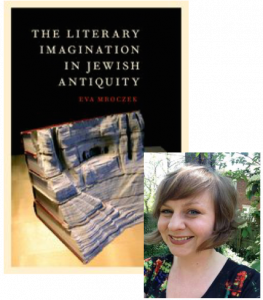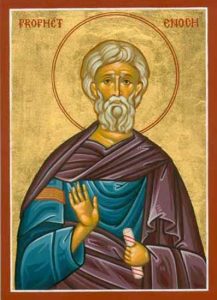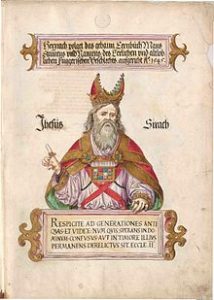 Don’t think of books. Think of open databases, literary projects, both earthly and heavenly archives. Ben Sirach, for example, becomes a generative character or figurehead from whom writings flowed like canals from a river. That’s how Eva Mroczek, Literary Imagination in Jewish Antiquity, says we should understand the way ancient Jewish scribes (Second Temple and gospel era) thought of their writings and their literary environment.
Don’t think of books. Think of open databases, literary projects, both earthly and heavenly archives. Ben Sirach, for example, becomes a generative character or figurehead from whom writings flowed like canals from a river. That’s how Eva Mroczek, Literary Imagination in Jewish Antiquity, says we should understand the way ancient Jewish scribes (Second Temple and gospel era) thought of their writings and their literary environment.
Revelation originated from the heavens and could never be grasped in all its fulness by any mortal; there was always room for more understanding and knowledge of the spiritual. There were writings that only the chosen few saints had ever seen, writings preserved in the heavens. Enoch was secreted away and continues to write until the time of the end.
A sacred writing could never be bound complete between two covers or within a single earthly scroll. There would always be room for more revelation. Of the making of books there will be no end.
An “author”, at least the inspired author, a heavenly figure perhaps, who sowed the poetry of praise or the sayings of wisdom in a mortal scribe, might spawn many varied works over time. Hence “David” could author countless psalms, only a small sample of which were ever captured for our canon. Other Davidic psalms were extant, some were composed relatively recently. They were all in a figurative sense authored by David since psalms were attributed to him as a way of fleshing out further the character and life of David. It was not so much that David’s name was attached to a psalm to impute authority to the psalm; no, it was rather that David was associated with the psalm to enrich the narrative about David, to transform David in a way to enable him to speak to a new audience. This world of attribution was not unique to the Judea’s:
In fact, such a sense of character-driven literary creativity is attested elsewhere in the ancient world, in some theories about Homer from the Hellenistic period, where the character becomes the affective centre of the poetic creation. Poetry . . . is generated from infatuation with one of the characters, who is prior to, and drives the creation of, the narrative. (p. 56)
So in the case of the Psalms of David. . .
Making psalms “Davidic” is not precisely attribution, as little evidence exists for a claim that David personally composed the psalms, but dramatisation and historicization. But this process of dramatising and historicising psalms is motivated not by the texts of the psalms themselves, but by an interest in the character who comes to animate the texts. It is the desire to reflect and elaborate on particularly compelling aspects of David’s character — David the sufferer, the penitent, the pursued — that is behind the creation of the expanded headings. Put simply, dramatising the psalms in his voice gives this David more things to say. (p. 63)
 We are not only talking about the Psalms of David and the different canonical counts of these but of the wider literary world — of writings attributed to Enoch, to Solomon, to Moses, to Abraham, to Zephaniah . . . . .
We are not only talking about the Psalms of David and the different canonical counts of these but of the wider literary world — of writings attributed to Enoch, to Solomon, to Moses, to Abraham, to Zephaniah . . . . .
In many Second Temple texts, we see an awareness of a literary world that is ancient, varied, and not fully accessible. In texts like Enoch, Jubilees, and many traditions about the patriarchs from the Dead Sea Scrolls, for instance, we see the notion of a long history of revealed writing stretching back long before Sinai, and forming part of the stories about Israel’s ancient ancestors. We see scribes recognizing the authority and divine origin of texts like the Enoch literature, Jubilees, and these patriarchal traditions, which present themselves not as derivative of or dependent on material we now call biblical, but indeed, prior to it. And while specific texts that have come down to us, like the Enochic material, are recognizably used in other literature, early Jewish texts also mention many writings that we cannot identify with any extant texts — writings that may have been lost, like the book of Noah, or were always only imagined, like the heavenly Book of Life.11 (pp. 116f.)
The authors of the scriptures (like Jubilees and the Temple Scroll) that not part of our canonical Bible did not appear to view their work as attempts to fill in the gaps or clarify and explain the canonical texts. These non-biblical texts do not present themselves as subordinate to the Pentateuch or Prophets, buy as new revelations from a divine source.
Indeed, in many cases, the later, non canonical work is of the same genre as the scriptural text it is supposed to be interpreting. That is, we have texts that draw on narrative, law, or prophecy we now call scriptural to create new narrative, law, or prophecy. (p. 120)
That is, the new texts would seem to take their place alongside the biblical works as new scriptures.
We may think of the canon as a closed set of documents to which all others must take a subordinate and outer place. But that’s not the literary world of the Second Temple era — nor of the time, I think it can be said, that the gospels were written. Instead,
We can see a world where revealed writing was not centralised in a single corpus but found in various locations, and where the history of inscription was a key part of the history of Israel’s ancestors. (p. 155)
But doesn’t Josephus tell us the Judeans had “twenty two sacred texts”? And 4 Ezra “Twenty four”? Doesn’t that mean the canon was pretty well set then as it is today? Yes, but it is not hard to discover that those numbers are symbolic, even “qualitative”, rather than mathematically exact — as I will show in another post.
 So we have many writings attributed to Abraham, to Moses, to David, to Solomon, to Enoch, to Ben Sirach. . . . .
So we have many writings attributed to Abraham, to Moses, to David, to Solomon, to Enoch, to Ben Sirach. . . . .
The literary imagination includes both sacred writings in multiple scopes, locations, and levels of accessibility and lore about writings taught to a varied cast of enlightened figures who had transcended their humanity. Thus, in the Second Temple period, we have neither a single central textual corpus, as in our dominant picture of later Judaism, nor a single ideal divinized figure, as in Christianity, that embodies the fullness of revelation. Rather, we have many texts that contain divine words, available or not, and several inspired heroes who had once heard and written them. Enoch, Jacob, and Ezra are all imbued with divine power. Each, in some way, has received and transmitted divine text, even if that text is contained in multiple locations, or only known in legend.
Their writing is part of—but not a replacement for—their inspired personalities, which continue to generate new traditions about their lives and characteristics. Many of the ancient figures credited with writing sacred texts are transformed into angelic or divine beings as the traditions about them develop— and many of them, in one source or another, dwell in heaven. Far from being replaced by the text of Deuteronomy, Moses takes on new roles as a scribe of more revelation beyond the Torah (Jubilees), but also as an angelic figure (Qumran); an ascended hero who never died, even though he claimed he did (Josephus); mind or soul alone (Philo); and a transfigured being who appears together with Elijah and Jesus. Enoch and David are divinely enlightened heroes who have prolific writing as part of their repertoires; in Jewish texts of late antiquity, both have become cosmic beings enthroned on high, continuing their mandates in heaven. Ezra leaves Torah for his community, but he himself receives not only greater writings reserved only for the wise but also greater rewards for himself, as a transformed being taken up to the heavenly world. . . .
And thinking beyond Mroczek’s exploration of the “Literary Imagination in Jewish Antiquity” I am reminded of the Gospel of John echo of the Ecclesiastes refrain
Jesus did many other things as well. If every one of them were written down, I suppose that even the whole world would not have room for the books that would be written. (John 21:25)
Is that another way of saying that there can be no end to the revelation of the mysteries of Jesus Christ? If the Gospel of John was written as a dialogue with the Gospel of Mark (as I suspect it was), is the author acknowledging more gospels will appear to “flesh out” the mystery and wisdom in Jesus? We do have reasons to think that the Gospel of John itself was added to by multiple authors over time.
And I also think of certain radical critics and most recently Thomas Brodie who argue that the Pauline corpus was produced by a school rather than the literary individual — each letter being another canal flowing from the river of the ideal character of Paul.
But not all revelation came via canals flowing from the river of a prophetic figure. Some, I tend to think, remained anonymous, with new wisdom that could only be revealed directly by the all-knowing narrative voice.
Neil Godfrey
Latest posts by Neil Godfrey (see all)
- Questioning the Hellenistic Date for the Hebrew Bible: Circular Argument - 2024-04-25 09:18:40 GMT+0000
- Origin of the Cyrus-Messiah Myth - 2024-04-24 09:32:42 GMT+0000
- No Evidence Cyrus allowed the Jews to Return - 2024-04-22 03:59:17 GMT+0000
If you enjoyed this post, please consider donating to Vridar. Thanks!

This was quite interesting. I haven’t read the book, so I don’t know if Mroczek refers to orality-literacy studies.
It sounds like Mroczek is describing a phenomenon of a culture of semi-literacy. The literates use writing for craft purposes; they do not use it frequently, to the point where it makes them feel different from the world around them (individuals), as we see in ancient Greek philosophy, for example. Instead, these semi-literates create texts intended to feed back into the oral society’s mythos. (The mythos consists of stories about “heavy” (stereotyped) characters, because such roles can accumulate and hold information, in the absence of literacy.)
The scribes/copyists probably see writing as no different from any other craft practiced in oral society. They don’t let writing change them. (The physical difficulty of writing probably had a lot to do with this.) They write to accrue more information onto David or Moses, in exactly the same way a Greek bard added details to a story about Odysseus.
It’s the original writers who nevertheless attribute their work to an ancient heavy character who are problematic. In some cases, like the author of the Shepherd of Hermas, the visionary may have been semi-literate, and the transcriber was more literate. For highly literate authors, perhaps it was a custom to write anonymously and attribute new material to old characters. Most of their audience would be illiterate or semiliterate anyway.
Hello! I just stumbled across this post, and I’d like to thank you for this very nice representation of what I was trying to show in the book. It’s always gratifying when a reader zeroes in on exactly those aspects I thought were most interesting and most central to my argument. Thank you for this careful and engaged reading of my work – much appreciated!
And thank you for an interesting discussion and insights.